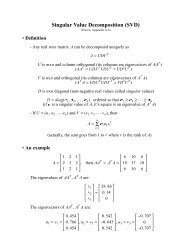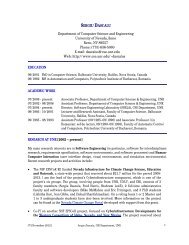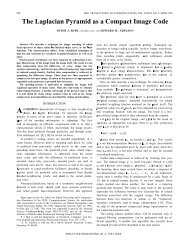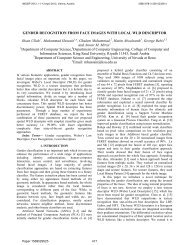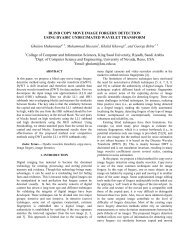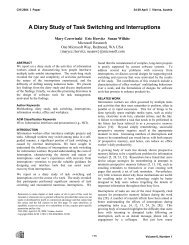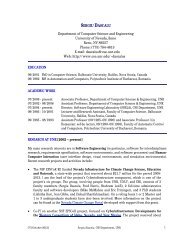Frequency Response Bound Determination Using a - CiteSeerX
Frequency Response Bound Determination Using a - CiteSeerX
Frequency Response Bound Determination Using a - CiteSeerX
Create successful ePaper yourself
Turn your PDF publications into a flip-book with our unique Google optimized e-Paper software.
<strong>Frequency</strong> <strong>Response</strong> <strong>Bound</strong> <strong>Determination</strong> <strong>Using</strong> a<br />
Kharitonov and Algorithmic Framework<br />
M. Sami Fadali L. LaForge Frederick C. Harris, Jr.<br />
Electrical Engineering The Right Stuff Computer Science<br />
University of Nevada 3341 Adler Court University of Nevada<br />
Reno, NV 89557 Reno, NV 89503 Reno, NV 89557<br />
fadali@ee.unr.edu larry@The-Right-Stuff.com fredh@cs.unr.edu<br />
Abstract<br />
This paper uses Kharitonov stability theory and the<br />
theory of algorithms to efficiently compute frequency<br />
response bounds for control system design. We limit the<br />
analysis to the simple case of a plant transfer function<br />
with denominator uncertainty to gain insight into the<br />
determination of tracking, robust stability, and actuator<br />
bounds. A coordinate transformation allows us to reduce<br />
the computational time for the problem. We divide the<br />
compensator plane into separate regions with each region<br />
sharing the critical points of a value set needed in the<br />
computation of frequency response bounds. Our analysis<br />
demonstrates the importance of estimating asymptotic<br />
bounds on computational time as is standard in<br />
algorithmic analysis. We apply our algorithms to a twosimple<br />
examples.<br />
I. Introduction<br />
In quantitative feedback theory (QFT), the frequency<br />
domain design of control systems is accomplished by<br />
robustly satisfying a set of performance inequality<br />
constraints. QFT and related methodologies provide an<br />
integrated design procedure to satisfy tracking, robust<br />
stability, actuator, sensitivity, and other performance<br />
constraints in the presence of parameter uncertainty. As<br />
originally proposed, QFT required extensive experience<br />
to obtain good results [1]. Today, computer programs<br />
have made it accessible to the average control engineer<br />
[2]. However, the computational cost of determining<br />
feasible compensators becomes prohibitive as the number<br />
of uncertain parameters increases.<br />
Several researchers have developed useful algorithms to<br />
reduce the time required to calculate the bounds used in<br />
QFT design [3], [4], [5], [6], [7]. In [3], the authors use<br />
value sets known from Kharitonov stability theory [8] to<br />
compute the tracking bounds for affine uncertainty in the<br />
numerator and denominator. In [4], QFT bounds are<br />
expressed as quadratic constraints to simplify their<br />
determination. Longdon and East [5] provide a<br />
geometrical technique for bound computation with the<br />
transfer function value set approximated by a polygon. It<br />
is well known that the value set of an affine polynomial is<br />
a polygon and the approach they provide can give only<br />
sufficient conditions for satisfying the design constraints.<br />
Fadali and LaForge [6] introduced the notation and<br />
tools of algorithmic analysis to the computation of QFT<br />
bounds. The analysis was restricted to the simple case of<br />
a system with denominator uncertainty and a numerator<br />
known with arbitrary accuracy. In [7], Fadali and<br />
LaForge give optimal algorithms for computing QFT<br />
bounds for interval numerator and denominator<br />
polynomials. These two papers demonstrate that to assess<br />
the relative usefulness of newly proposed algorithms, it is<br />
essential to obtain asymptotic bounds on their<br />
computational time and to formally prove their<br />
correctness as is standard practice in algorithmic design.<br />
The authors of [3] and [5] observed that the magnitude<br />
of the sum of a test compensation value (complex<br />
number) and a plant value set is the distance between the<br />
value set and the negative of the compensation value.<br />
This observation is the key to significant computational<br />
savings. For example, the upper bound on the closed loop<br />
frequency response (stability robustness bound) can be<br />
calculated by determining the minimum distance to a<br />
value set. Lower bound computation can be calculated by<br />
determining the maximum distance to a value set. The<br />
classical ratio tracking bound for QFT is an upper bound<br />
on the ratio of the maximum distance to the minimum<br />
distance to the value set.<br />
In this paper, we further examine the simple problem<br />
solved in [6] and exploit the same observation. We show<br />
that in special cases the complex plane can be divided into<br />
regions where the farthest and closest points of the value<br />
set remain unchanged. A coordinate transformation<br />
simplifies the evaluation of both the stability robustness<br />
and tracking bounds by reducing the problem to one<br />
where the bounds are symmetric about the value set. The<br />
inverse transformation yields the required bounds, and the<br />
entire computation is achieved in constant time. These<br />
concepts are explained in this paper and demonstrated<br />
using two simple examples.<br />
This paper is organized as follows: First, we examine<br />
the tracking and stability robustness bounds for a system<br />
with interval denominator uncertainty. Next, we introduce<br />
the coordinate transformation that simplifies the<br />
computation of the required QFT bounds and show that<br />
the complex plane can be divided into twelve regions<br />
(three when symmetry is considered) each of which has a<br />
fixed farthest and closest point in the rectangular value<br />
set. We then discuss the computational time [9] of the<br />
new algorithm as compared to [6] and to the standard<br />
gridding approach [2], [10]. Finally, we apply the new<br />
concepts to two simple examples.
II. <strong>Frequency</strong> <strong>Response</strong> <strong>Bound</strong>s<br />
Consider a single-input-single-output system comprised<br />
of a plant and a feedback compensator. The closed-loop<br />
transfer function (CLTF) for the system is given by<br />
−1<br />
T ( ω) = 1 P ( jω,<br />
p,<br />
q)<br />
+ K(<br />
jω)<br />
where P is the uncertain plant transfer function, K is a<br />
compensator transfer function, and p and q are vectors of<br />
uncertain parameters for the numerator and denominator<br />
polynomials, respectively. We now discuss some design<br />
bounds commonly used in the literature. For a more<br />
complete account of these and other bounds, the reader is<br />
referred to the literature on QFT [1], [2].<br />
Because we are primarily interested in the development<br />
of new computational tools for frequency response<br />
bounds, we focus our attention on the simplest<br />
meaningful problem for which those tools can be<br />
explored. We consider the case of a plant transfer<br />
function with denominator uncertainty<br />
P( jω<br />
, p,<br />
q)<br />
= N(<br />
jω)<br />
D(<br />
jω,<br />
q)<br />
(2)<br />
The maximum CLTF magnitude is therefore given by<br />
T ( ω) = N(<br />
jω)<br />
min D(<br />
jω,<br />
q)<br />
+ KN(<br />
jω)<br />
(3)<br />
max<br />
q<br />
(1)<br />
and the minimum CLTF magnitude is<br />
T ( ω) = N(<br />
jω)<br />
max D(<br />
jω,<br />
q)<br />
+ KN(<br />
jω)<br />
(4)<br />
min<br />
q<br />
The worst-case magnitude ratio is<br />
max D(<br />
jω,<br />
q)<br />
+ KN(<br />
jω)<br />
T(<br />
ω)<br />
max q<br />
= (5)<br />
T(<br />
ω)<br />
min D(<br />
jω,<br />
q)<br />
+ KN(<br />
jω)<br />
min<br />
q<br />
Let C = xc+ j yc be the product of K and N and rewrite (5)<br />
as<br />
max D(<br />
jω,<br />
q)<br />
+ C(<br />
jω)<br />
T(<br />
ω)<br />
max q<br />
= (6)<br />
T(<br />
ω)<br />
min D(<br />
jω,<br />
q)<br />
+ C(<br />
jω)<br />
min<br />
q<br />
It will be convenient to rewrite (6) in the form<br />
max D(<br />
jω,<br />
q)<br />
−C<br />
( jω)<br />
T(<br />
ω)<br />
m<br />
max q<br />
= (7)<br />
T(<br />
ω)<br />
min D(<br />
jω,<br />
q)<br />
−C<br />
( jω)<br />
min<br />
q<br />
m<br />
where Cm = −C = (−xc, −yc) =(x, y). We now observe that<br />
the magnitudes in (3)-(7) involve distances between the<br />
values of the complex number D and the complex number<br />
Cm [3]. Thus, determining QFT tracking bounds is<br />
equivalent to determining the ratio of the maximum to<br />
minimum distance between the point Cm and the set D.<br />
In addition, robust stability requires satisfying<br />
N(<br />
jω)<br />
T ( ω ) = ≤ M , > 0<br />
max<br />
p M p (8)<br />
min D(<br />
jω,<br />
q)<br />
− C<br />
i.e.<br />
q<br />
m<br />
q M p<br />
m<br />
N(<br />
jω)<br />
min D(<br />
jω,<br />
q)<br />
− C ≥<br />
(9)<br />
For cascade compensation, (7) is unchanged, but the right<br />
hand side of (9) is multiplied by |K|. Similarly, the lower<br />
bound<br />
N(<br />
jω)<br />
T ( ω ) = ≥ M l , M l > 0 (10)<br />
mi min D(<br />
jω,<br />
q)<br />
− C<br />
q<br />
m<br />
is equivalent to the condition<br />
min D(<br />
jω,<br />
q)<br />
− C ≤<br />
N(<br />
jω)<br />
(11)<br />
m<br />
q M l<br />
The tracking bound (7) yields an upper bound similar to<br />
(8) and a lower bound similar to (10). However, the<br />
computation of (8) and (10) is simpler. Furthermore, it is<br />
identical with the constant Mp and Ml used for (8) and<br />
(10), respectively. In later sections we use Mlp to denote<br />
either constant as we discuss our computational<br />
procedure.<br />
Let D be the nth order interval polynomial<br />
D(s; q) = an(q) s n + an − 1(q) s n − 1 + … + a0(q) (12)<br />
− +<br />
with uncertainty bounds a ∈ a , a , i = 0, 1,…, n.<br />
i i i<br />
Then the value set associated with the uncertain<br />
polynomial is the Kharitonov rectangle D with<br />
generating polynomials [8]<br />
++ + + − 2 −<br />
D ( s)= a + a s+ a s + a s +<br />
0 1 2<br />
3<br />
3 L<br />
+− + − − 2 +<br />
D ()= s a + a s+ a s + a s +<br />
0 1 2<br />
3<br />
3 L<br />
−+ − + + 2 −<br />
D ()= s a + a s+ a s + a s +<br />
0 1 2<br />
3<br />
3 L<br />
−− − − + 2 + 3<br />
D ()= s a + a s+ a s + a s + L (13)<br />
0 1 2<br />
3<br />
Refer to Figure 1; (x, y) ∈ D if and only if<br />
x− ≤ x ≤ x+ , y− ≤ y ≤ y+ (14)<br />
where x+ (resp. x−) denotes the real component of D ++<br />
(resp. D −− ) and y+ (resp. y−) denotes the imaginary<br />
component of D ++ (resp. D −− ).<br />
We show that the maximum and minimum magnitude<br />
corresponds either to an extreme point of the value set D<br />
or to a point on an edge of D . Algorithmic computation<br />
of the minimum magnitude, maximum magnitude, and<br />
worst-case ratio is now tractable.<br />
y+<br />
y-<br />
Im{D}<br />
D -+<br />
- -<br />
D<br />
x- x+<br />
D ++<br />
D +-<br />
Re{D}<br />
Fig. 1 Kharitonov rectangle D .<br />
III. Coordinate Transformation and the Maximum<br />
and Minimum Distance<br />
To determine the stability robustness and tracking<br />
bounds for a system with denominator uncertainty, we<br />
obtain the maximum and minimum distances between a
test point Cm = (x, y) and the Kharitonov rectangle D . We<br />
use the notation<br />
⎛ x−<br />
+ x+<br />
y−<br />
+ y+<br />
⎞<br />
( xav , yav<br />
) = ⎜ , ⎟ (15)<br />
⎝ 2 2 ⎠<br />
The plane can be divided into 12 regions. Within<br />
region i, there is a unique point ( x y ∈D at maximum<br />
(<br />
distance from Cm and a unique point ( ∈D at<br />
minimum distance. We do not consider the interior of the<br />
Kharitonov rectangle since it corresponds to unstable<br />
systems.<br />
) ) , )<br />
x y)<br />
( ( ,<br />
Before we show the results of dividing the plane into<br />
regions, we discuss a coordinate transformation to reduce<br />
the subdivision of the complex plane for compensation<br />
boundary calculation to one where we have symmetry that<br />
can be exploited to reduce computation. We transform<br />
the compensation to (x, y) using<br />
⎡x⎤<br />
⎡x<br />
c ⎤ ⎡x<br />
av ⎤ ⎡x<br />
c ⎤ ⎡x⎤<br />
⎡x<br />
av ⎤<br />
⎢ ⎥ = −⎢<br />
⎥ − ⎢ ⎥ ↔ ⎢ ⎥ = −⎢<br />
⎥ − ⎢ ⎥<br />
⎣y⎦<br />
⎣y<br />
c ⎦ ⎣y<br />
av ⎦ ⎣y<br />
c ⎦ ⎣y⎦<br />
⎣y<br />
av ⎦<br />
Im{D}<br />
D<br />
III<br />
Re{D}<br />
++<br />
D --<br />
D -+<br />
D +-<br />
II<br />
I<br />
yf<br />
−yf<br />
−xf xf<br />
Fig. 2 The transformed Kharitonov rectangle.<br />
The transformed region has as its origin the center of<br />
the Kharitonov rectangle as shown in Figure 2. Only the<br />
three regions where x and y are both positive need be<br />
considered because of the symmetry resulting from the<br />
transformation. For each point (x, y) on a boundary,<br />
symmetry yields the set of boundary points {(x,y), (−x,y),<br />
(x,−y), (−x,−y)}. Transforming back to the original<br />
coordinates, we have the four points {(−x−xav,−y−yav),<br />
(x−xav,−y−yav), (−x−xav,y−yav), (x−xav,y−yav)}.<br />
Theorem 1. Given a rectangular region D and a test<br />
point (x, y), the farthest point ( x y in D to (x, y) and the<br />
closest point in D to (x, y) are as given in Table 1.<br />
) ) , )<br />
( x y)<br />
( ( ,<br />
Table 1. Closest and Farthest Points for the<br />
Transformed Domain.<br />
Region ( x y)<br />
( ( , ( x y)<br />
) ) Proof: The distance D to (x, y) is maximized or<br />
) 2<br />
minimized by separately maximizing ( x − x)<br />
and<br />
) 2<br />
( 2 ( 2<br />
y − y)<br />
or minimizing ( x − x)<br />
and ( y − y)<br />
, respectively.<br />
) 2<br />
For the horizontal direction, ( x − x)<br />
is maximized at<br />
)<br />
( 2<br />
(<br />
x =−xf.<br />
( x − x)<br />
is minimized in II and III at x = xf.<br />
In Region I a minimum value of zero is possible with<br />
(<br />
x = x.<br />
The vertical distances can be similarly obtained to<br />
complete Table 1. ■<br />
For each region the tracking bound is defined by<br />
) 2 ) 2<br />
2 ( x − x)<br />
+ ( y − y)<br />
2<br />
R = ( 2 ( ≤ B<br />
(16)<br />
2<br />
( x − x)<br />
+ ( y − y)<br />
with B > 1. At the boundary in Region II, we have<br />
2 2<br />
2 ( ) 2 ( 2 ) 2<br />
( B −1)<br />
x − 2x(<br />
B x − x)<br />
+ ( B x − x )<br />
2 2<br />
2 ( ) 2 ( 2 )<br />
(17)<br />
2<br />
+ ( B −1)<br />
y − 2y(<br />
B y − y)<br />
+ ( B y − y ) = 0<br />
with the permissible region outside the boundary.<br />
Completing the squares gives the equation of the circle<br />
with center (c x, c y)<br />
and radius cr<br />
2<br />
2 2<br />
( x − c x ) + ( y − c y ) = cr<br />
(18)<br />
( ) ( ) ( ) ( ) ( )<br />
( ) ( )<br />
,<br />
I (x, yf) (−xf,−yf)<br />
II (xf, yf) (−xf,−yf)<br />
III (xf, y) (−xf,−yf)<br />
2<br />
2<br />
2<br />
2<br />
2 ( ) 2<br />
c x = B x − x B −1<br />
, c y = B y − y B −1<br />
B ) ( ) (<br />
(19)<br />
cr<br />
= x − x + y − y<br />
2<br />
B −1<br />
In Regions I and III, one quadratic term in the<br />
denominator vanishes. For Region I, (17) becomes<br />
2 2<br />
2 ( ) ) 2 2 ( 2 ) 2<br />
( B −1) y − 2y(<br />
B y − y)<br />
− ( x − x)<br />
+ ( B y − y ) = 0 (20)<br />
Completing the squares we have the hyperbola<br />
) 2<br />
2<br />
( x − x)<br />
( y − c y )<br />
− + = 1<br />
(21)<br />
2 2<br />
2<br />
c ry ( B −1)<br />
c ry<br />
where<br />
) ( 2<br />
cry<br />
= B y − y ( B −1)<br />
= cr with the x-related terms<br />
removed. The hyperbola is symmetric about axes through<br />
( x, c y ) )<br />
2<br />
with x-intercept at ⎜<br />
⎛ 2<br />
x ± c B −1⎟<br />
⎞<br />
ry ⎝ ⎠<br />
)<br />
with<br />
asymptotes through ( x, cy<br />
) )<br />
and cy ± cry. In Region III, we<br />
have similar hyperbolas with x and y interchanged and<br />
( ) r c = −1<br />
) ( 2<br />
c rx = B x − x B with the y-related terms<br />
removed.<br />
Each boundary is valid only for the region for which the<br />
points ( x y and ( apply. In Region II, compensation<br />
is allowed outside the circle where the ratio is less<br />
than the specified value. In the remaining regions, the<br />
allowable compensation is outside the hyperbolas.<br />
) ) , ) x y)<br />
( ( ,<br />
From (9) or (11), we obtain a boundary by replacing the<br />
inequality with an equality<br />
( 2 ( 2<br />
2<br />
( x − x)<br />
+ ( y − y)<br />
= ( N M lp )<br />
(22)<br />
where Mlp denotes either the upper bound Mp or the lower<br />
bound Ml. The boundary is a circle of center ( x y)<br />
and<br />
radius N/Mlp. The allowable region is outside the circle.<br />
( ( ,
The actuator bound is due to the maximum allowable<br />
compensation magnitude γmax at each frequency. It is<br />
defined by the equation<br />
2 2 2<br />
x + y ≤ γ max<br />
(23)<br />
This boundary is a circle centered at the origin with radius<br />
γmax, and the allowable region is inside the circle.<br />
Theorem 2. Let the points ( x y and ( be known for<br />
( )<br />
1<br />
a system with fixed numerator and interval denominator<br />
polynomial. The compensation boundaries and<br />
) ) , ) x y)<br />
( ( This indicates a positive derivative with the inadmissible<br />
,<br />
negative root x=−xf. Differentiating with respect to y and<br />
equating to zero, we obtain<br />
2<br />
2<br />
2<br />
∂R<br />
y + y f ( y − y f ) − [ ( y + y f ) + ( x + x f ) ]<br />
=<br />
= 0<br />
2<br />
3<br />
∂y<br />
( y − y f )<br />
2 ( x + x f ) + 2y<br />
f ( y + y f ) = 0<br />
This indicates a positive derivative with the inadmissible<br />
negative root<br />
y = −y<br />
− x + x<br />
2<br />
2y<br />
permissible regions are given by<br />
1) In Region II, the tracking boundary is a circle of<br />
radius cr centered at (−cx,−cy) with the permissible<br />
region outside the boundary. In Region I, the tracking<br />
boundary is a hyperbola symmetric with respect to<br />
axes through ( − x, −c<br />
y ) )<br />
with horizontal intercept at<br />
) 2<br />
− x ± B −1<br />
− x, −c<br />
)<br />
and<br />
and asymptotes through ( )<br />
−cy±cry. In Region III, the tracking boundary is a<br />
hyperbola symmetric with respect to axes through<br />
)<br />
) 2 ( − c x , −y<br />
) with horizontal intercept at − y ± B −1<br />
)<br />
and asymptotes through ( − c x , −y<br />
) and −cx±crx.<br />
2) The upper or lower boundary is a circle of radius<br />
( (<br />
N/Mlp centered at ( − x,<br />
−y<br />
) with the permissible region<br />
outside the boundary.<br />
3) The actuator boundary is a circle of radius γmax<br />
centered at the origin with the permissible region<br />
inside the boundary.<br />
Proof: The results are obtained on replacing (x,y) by<br />
(−x,−y) in (16), (17), (18). ■<br />
Remark 1: Theorem 2 is valid only if we fix the farthest<br />
and closest points in the Kharitonov rectangle to a test<br />
point. In Regions I and II this is not the case. The result<br />
is that the robust stability boundaries in these regions are<br />
actually straight lines parallel to the adjacent edge of<br />
Kharitonov rectangle and tangent to the set of circles for<br />
the region.<br />
We assume that we remain in a single region so that the<br />
points for maximum and minimum distances are fixed to<br />
derive the following monotonicity properties.<br />
Theorem 3. The function (1) is monotone increasing in<br />
Region I or III and is unimodal in Region II.<br />
Proof: Differentiate the rational function of (16) and<br />
equate to zero to obtain the minima and maxima. For<br />
( )<br />
Region I, x = x and x = −x<br />
, so that (16) reduces to<br />
R<br />
2<br />
=<br />
2 ( x + x f ) + ( y + y f )<br />
2 ( y − y )<br />
f<br />
2<br />
f<br />
≤ B<br />
Differentiating w.r.t. x and equating to zero gives<br />
2<br />
1 ∂R<br />
2<br />
∂x<br />
=<br />
x + x f<br />
2<br />
y − y<br />
= 0<br />
( )<br />
f<br />
2<br />
y<br />
f<br />
( ) ( )<br />
f<br />
f<br />
Because the derivatives are positive and have no positive<br />
real roots we conclude that the function is montone<br />
increasing.<br />
Interchanging x and y, we prove monotonicity in<br />
(<br />
Region III. In Region II, x = and f , so that x x − =<br />
)<br />
(16) becomes:<br />
2<br />
R =<br />
x + x f<br />
x − x<br />
∂R<br />
∂x<br />
2<br />
2<br />
( ) + ( y + y f ) 2<br />
≤ B<br />
2<br />
2<br />
( f ) + ( y − y f )<br />
2 2<br />
2 2<br />
− 2x<br />
f ( x − x f ) − 4yy<br />
f x + 2x<br />
f [ y + y f ]<br />
=<br />
2<br />
2 2<br />
( x − x ) + ( y − y )<br />
2<br />
1 =<br />
2<br />
This yields the roots<br />
x f<br />
[ ]<br />
f<br />
2 2 2 2<br />
( yy x ) ± ( yy x ) + y + y x<br />
x = −<br />
+<br />
f<br />
f<br />
f<br />
f<br />
One root is negative and is therefore inadmissible. The<br />
second root is greater than xf and is therefore inside<br />
Region II. Therefore, the function is unimodal in Region<br />
II. For large x the function approaches its minimum value<br />
of unity. We conclude that in Region II, the inadmissible<br />
region is in the vicinity of a maximum of the ratio R 2 as<br />
shown in Figure 3. Because the value of R 2 as x → xf may<br />
be larger than B 2 , the intersection of the curve of Figure 3<br />
with the R 2 = B 2 line may occur at one or two points. ■<br />
R 2<br />
1<br />
xf<br />
Fig. 3 Unimodal function in Region II.<br />
The coordinate transformation is linear, and the<br />
boundaries retain their form. However, the<br />
transformation reveals the following regarding the<br />
stability robustness boundary of Theorem 2.<br />
Theorem 4. The upper and lower frequency response<br />
boundaries for the transformed domain in Regions I and<br />
III are straight lines parallel to the edges of the<br />
f<br />
f<br />
x<br />
f<br />
0
Kharitonov rectangle. In Region II, the boundary is a<br />
circle of radius N/Mlp centered at (xf, yf).<br />
Proof: The upper (stability robustness) or lower boundary<br />
is given by (22) with ( x y defined for Regions I, II, III.<br />
In Region I,<br />
( ( , )<br />
x, y = x, y<br />
( (<br />
, and the boundary is the<br />
( ) ( )<br />
f<br />
vertical line y = y f + N M lp . Similarly, in Region III,<br />
the boundary is the vertical line x = x f + N M lp . In<br />
(<br />
x , y = x ,<br />
(<br />
, and the boundary is the<br />
Region II, ( ) ( f y f )<br />
circle ( ) ( ) ( ) 2<br />
2<br />
2<br />
y − y + x − x = N M<br />
f f<br />
lp<br />
■<br />
Remark 2: Transforming the rectangle using the inverse<br />
transformation of (22) gives a second rectangle centered<br />
at (−xav,−yav) with the symmetric boundaries about the<br />
rectangle. Hence, the boundaries and the permissible<br />
compensation can be plotted easily.<br />
Remark 3: For fixed numerator and affine denominator<br />
uncertainty structure, the denominator value set is a<br />
polygon. The upper and lower frequency response<br />
boundaries are made up of edges parallel to the edges of<br />
the polygon and circular arcs around the vertices. For a<br />
multiaffine denominator, the convex hull of the value set<br />
is a polygon [7], and a somewhat conservative robust<br />
stability bound can be explicitly obtained.<br />
IV. Algorithm for Feasible Compensation Region<br />
We now state the main algorithmic result of this paper.<br />
In (2) let the order of the numerator polynomial N be m<br />
and the order of the uncertain denominator polynomial D<br />
be n. Horner's Rule evaluates these polynomials in time<br />
θ(m) resp. θ(n) ([8], ex. 1.2-4). The numerator need be<br />
evaluated only once, but in order to compute the<br />
Kharitonov rectangle, the denominator is recomputed (in<br />
optimal time θ(n)) for each of nw sample frequencies ω.<br />
For fixed ω, Theorem 2 prescribes how to determine, in<br />
optimal time θ(1), a set of constraints defining the<br />
feasible region of compensation. Thus, in time θ(nwn+m),<br />
the frequency-divided boundary of minimum magnitude<br />
compensations can be computed. When, as is often the<br />
case, nw n is much greater than m, the running time is<br />
θ(nw n). This compares favorably with the θ(nw nγ nφ n)<br />
running time of [6] and is certainly preferable to the θ(nq<br />
nw nγ nφ n) running time of the traditional gridding<br />
approach [9], where nq is the total number of grid points<br />
in the uncertain parallelepiped Q, nγ is the number of grid<br />
points along the axis of compensation magnitude, and nφ<br />
is the number of points along the compensation phase<br />
axis. Since the numerator need be evaluated only once,<br />
the Rule of Products implies that the search as described<br />
runs in time θ(nqnwnγ nφn+m).<br />
To demonstrate the reduction in computational time<br />
achieved here, we examine the case of a plant transfer<br />
function with six uncertain parameters and ten grid points<br />
for each parameter nq=10 6 . For nγ = nφ = 10, the overall<br />
reduction achieved here is by a factor of one hundred<br />
relative to [6] and 10 8 relative to the gridding method!<br />
In the next section, we discuss two simple examples to<br />
illustrate our computational approach to bound<br />
determination. We purposefully avoid more complex<br />
examples that would obscure the design procedure.<br />
V. Examples<br />
Example 1: Position Control System<br />
Consider the position control system with motor and<br />
G s = 10 s τ s + 1 , where τ ∈[8,<br />
load transfer function () [ ( ) ]<br />
12]. The product of the numerator of the transfer function<br />
and the compensator K is C = 10K. The denominator is<br />
an interval polynomial whose value set is the interval<br />
[−8ω 2 ,−12ω 2 ] on the straight line parallel to the real axis<br />
with imaginary intercept ω. Here, the twelve regions of<br />
Figure 2 reduce to 6 and the three regions of Figure 4<br />
reduce to two. The bounds for the system are shown in<br />
Figure 5 together with the value set for ω=1rad/s.<br />
For this example, cry is zero and the hyperbolas for<br />
Region I, reduce to a single point outside the respective<br />
region. Region III, are not defined and need not be<br />
considered. In Region II, the tracking boundaries are<br />
circular arcs with the permissible region outside the arcs.<br />
The stability robustness boundary comprises circular arcs<br />
of radius N/Mp = 5 and straight lines parallel to the value<br />
set. The actuator bound is a circle of radius γact. The<br />
feasible compensation region is inside the actuator<br />
boundary and outside both the tracking boundary and the<br />
stability robustness boundary.<br />
Fig. 5 <strong>Bound</strong>aries for position control system.<br />
Example 2: Two-Parameter Uncertainty<br />
2<br />
Consider the transfer function G s)<br />
= 1 [ a s + a s + 1]<br />
( 2 1<br />
where ai ∈[ ai − , ai + ], i =1, 2. For G(jω), the x and y<br />
coordinates of the denominator are in the ranges<br />
x ∈ [1 − a2 + ω 2 , 1 − a2 − ω 2 ], y ∈ [a1 − ω, a1 + ω]. The QFT
ounds are shown in Figure 4. The permissible region is<br />
inside the circle of the actuator bound, outside the<br />
tracking bounds made up of hyperbolic and circular<br />
segments and outside the robust stability bounds. We<br />
select a design point for each point on a frequency grid.<br />
We then fit the set of design points with a compensator.<br />
Finally, we check the compensated system to determine if<br />
all design constraints are satisfied. We can also add the<br />
bounds of the form (10) to Figure 4 so that the designer<br />
can attempt to satisfy all design constraints with a single<br />
compensator. If successful, the added cost of a prefilter<br />
can be avoided. If not, we ignore the additional bound<br />
and design a loop compensator. We then add a prefilter to<br />
achieve the desired performance.<br />
Fig. 4 QFT boundaries for the two-parameter system.<br />
V. Conclusion<br />
The simple case considered in this paper demonstrates<br />
the considerable savings possible in the computation of<br />
QFT bounds using value sets, coordinate transformations,<br />
and subdivision of the compensator plane. For a region<br />
where the farthest and closest points in the value set to a<br />
test point are determined, closed form expressions for the<br />
boundaries are obtained. This allows the computation of<br />
the compensation bounds in time θ(nwn).<br />
For a system with a more complex denominator<br />
structure, the upper (robust stability) bound and the lower<br />
bound can be calculated as outlined in Remark 3. These<br />
problems will be examined by the authors in more detail<br />
in future work. However, it may be difficult to extend the<br />
results obtained here to tracking bounds expressed as a<br />
ratio of maximum to minimum frequency response. This<br />
further justifies the move by QFT researchers [4] to<br />
abandon ratio tracking bounds and specify tracking using<br />
an upper and lower bound to simplify the design<br />
procedure and improve its computational efficiency.<br />
References<br />
[1] J. J. D'Azzo & C. H. Houpis (1988). Linear Control<br />
System Analysis and Design. McGraw-Hill Book<br />
Company, New York.<br />
[2] C. Borghesani, C., Y. Chait & O. Yaniv (1994).<br />
Quantitative feedback theory toolbox. The<br />
Mathworks Inc., Natick, MA.<br />
[3] M. Brown & I. R. Peterson (1991). Exact<br />
computation for the Horowitz bound for interval<br />
plants. 30th CDC, Brighton, England, pp. 2268-2273.<br />
[4] G. M. Rodriguez, Y. Chait & C. V. Hollot (1995). A<br />
new algorithm for computing QFT bounds. Proc.<br />
1995 ACC, Seattle, WA.<br />
[5] L. Longdon & D. J. East (1979). A simple<br />
geometrical technique for determining loop frequency<br />
response bounds which achieve prescribed sensitivity<br />
specifications. Int. J. Control, 30, pp. 153-158.<br />
[6] M. S. Fadali & L. E. LaForge, Algorithmic Analysis<br />
of Geometrically Computed QFT <strong>Bound</strong>s, Proc. 1996<br />
IFAC World Congress, Vol. H, pp. 297-302. San<br />
Francisco, CA, June, 1996.<br />
[7] M. S. Fadali and L. E. LaForge (2001). Linear time<br />
computation of feasible regions for robust<br />
Compensators, J. Robust and Nonlinear Control, 11,<br />
pp. 819-856.<br />
[8] B. K. Barmish, (1994). New Tools for Robustness of<br />
Linear Systems. Macmillan, NY, NY.<br />
[9] T. H. Cormen, C. E. Leiserson & R. L. Rivest (1993).<br />
Introduction to Algorithms. McGraw Hill, NY, NY.<br />
[10] El-Zayyat, K.(1994). VSC/QFT Robust Design of<br />
Systems with <strong>Bound</strong>ed Uncertainties, Ph.D. Dissert.,<br />
(M. S. Fadali, Advisor), UNR, Reno, NV.



